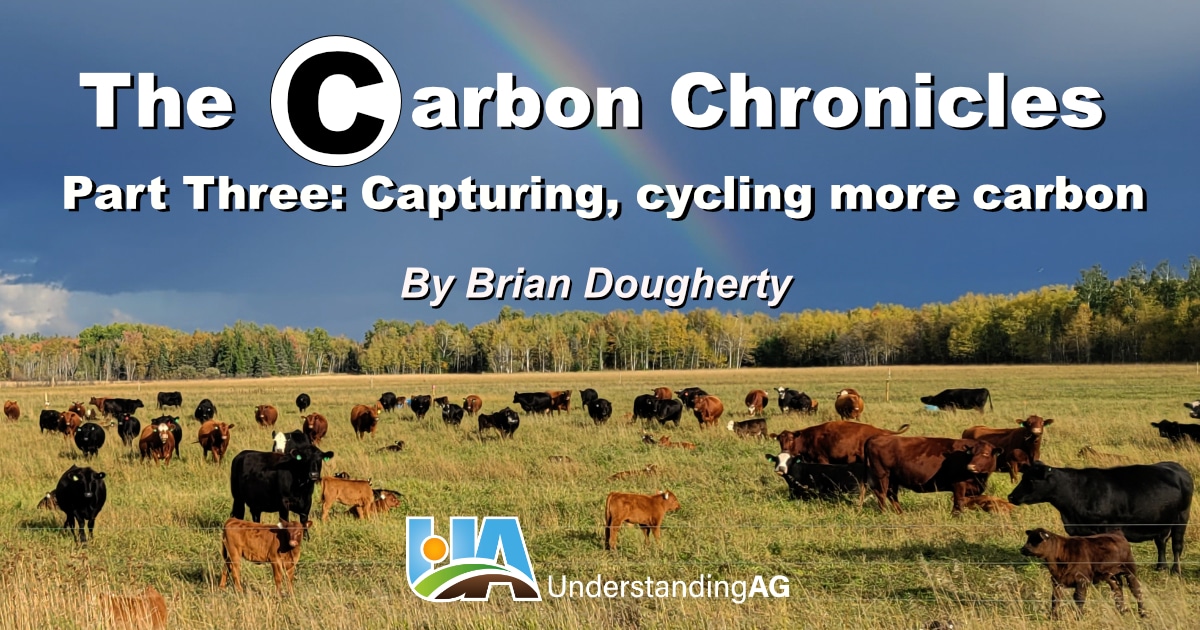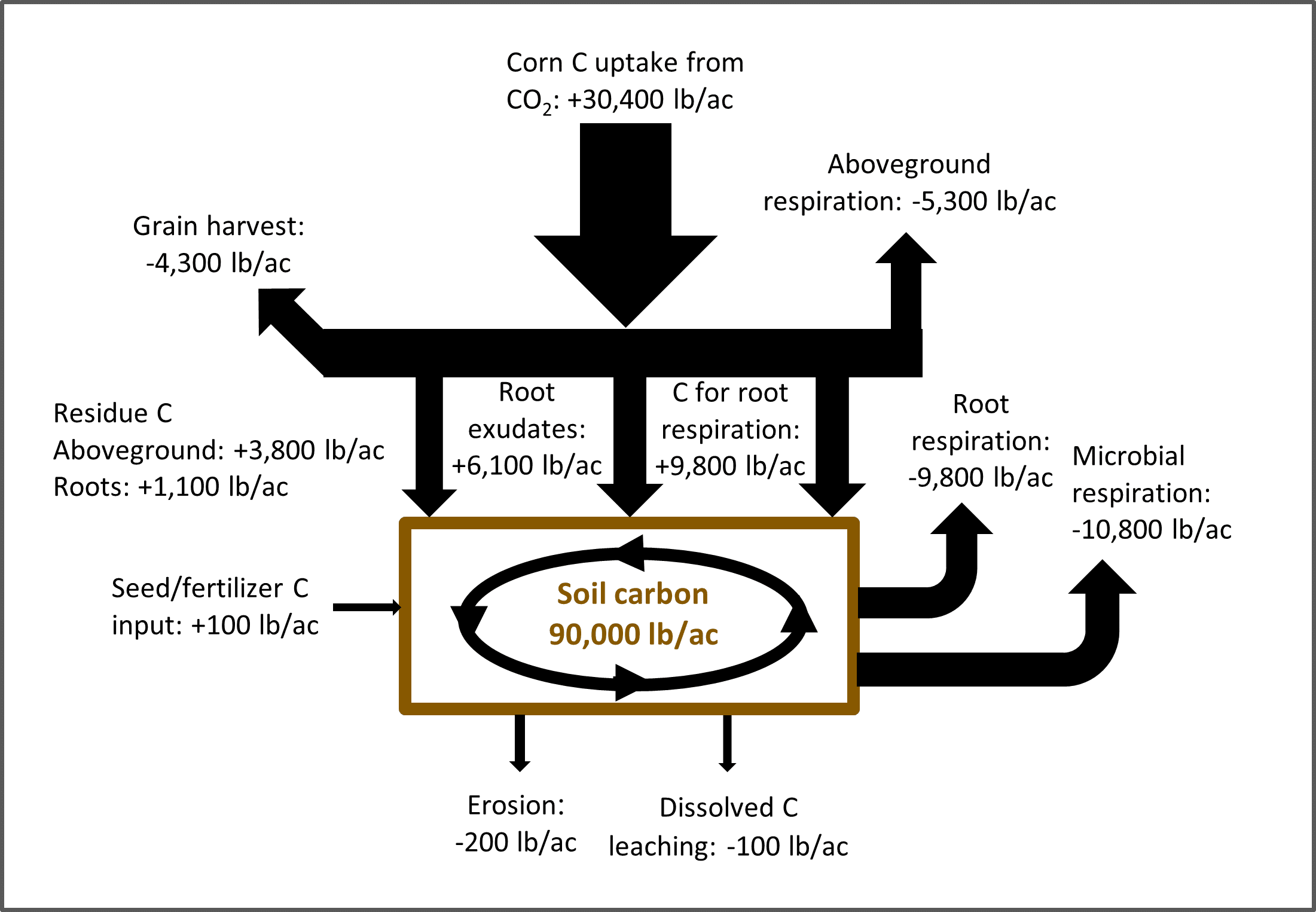
The first two parts of this series examined the critical role of carbon in powering plant and soil life (all terrestrial life) and the cyclic outflow from an average corn field. Now let’s look at inflows.
Unsurprisingly, the lack of photosynthesizing plant cover throughout the growing season makes the carbon inflows smaller. Maintaining living cover throughout the growing season is the best and easiest way to increase carbon flow into the soil. Plant photosynthesis is by far our biggest arrow. The corn crop in the diagram emerges and reaches maturity in about 120 days. The remaining growing days are lost opportunity if there is no living cover. Adding a cover crop adds a new inflow, and it’s more likely that a portion of that carbon will stay in the soil if that cover crop is not harvested. Adding a perennial to the crop rotation can also drive a large increase in photosynthesis. Diversity in the cover crops or perennials increases photosynthetic activity even more. Farmers switching from tillage and fallow to a no-till cover crop system or from set stocked to adaptive grazing often see an increase in soil organic matter. Why? Because they have reduced the outflow and increased the inflow of carbon. You can also add carbon via humic products or compost, but the most efficient route is to let plants do the work for us.
Fertilizers and animal manures are a special case, because whether the ultimate result is net positive or negative depends on how they are managed. Animals in a well-managed adaptive grazing system tend to have an overall net positive impact. This can be quite large and drives the most rapid increases in soil organic matter that can be achieved without bringing in a large amount of biomass from somewhere else. On the other hand, poor fertility management can have a detrimental effect. Overapplying fertilizers or manure (especially high N fertilizers or anaerobic pit manure) can create nutrient imbalances, increase salt loads, and disrupt soil function. Adding too much nitrogen has the same result as tillage. It can spike microbial activity and drive the conversion of organic matter to CO2. However, manure does add carbon to the system so the net effect is hard to predict. Excesses of other nutrients can also cause nutritional imbalances in the plant that limit productivity.

There is one more way to increase the inflow of carbon that is almost always overlooked. Can you guess what it is? Many researchers believe that it is not possible to increase soil organic matter much beyond 0.1% per year. They prove this using the exact same math that you see in the diagram. But what if one of the underlying assumptions is wrong? Photosynthetic efficiency is typically assumed to be constant when these calculations are done. This is the amount of light energy that is converted into chemical energy during photosynthesis.
But what if that chemical energy input is not constant? What happens if the plant converts a greater percentage of sunlight, CO2, and water to biomass and root exudates? We now have a bigger arrow from the same ground cover. What if that same corn crop pulled in 50,000 lb of carbon per acre instead of 30,000? What if your adaptive grazing system leads to a large increase in plant productivity and carrying capacity? Now you have a much larger flow through the plants and extra carbon available for storage in the soil.
There is research that actually proves this, but it’s often disregarded because it is very hard to predict. Root exudation can vary from as little as 5% to as much as 95% of photosynthate production. That is a huge range and will vary depending on plant species, stage of growth, environmental conditions, and soil function. The majority of soil organic matter actually comes from microbes consuming root exudates and creating carbon compounds that stick to soil particles. In the diagram, root exudation is 20% of photosynthate production. What if we had more exudates?
To improve photosynthetic efficiency, the plant must be able to access adequate mineral nutrition in the proper balance and grow in well aggregated soil that provides optimal conditions for the plant. What limits photosynthesis? The two main inputs are CO2 and water, thus one or both are most likely limiting factors. Following the soil health principles to improve water infiltration and water holding capacity will increase water availability to the plant. What about CO2? Look at the diagram. Is there a source of CO2 right where the plant needs it? Yes! You can improve photosynthetic efficiency by increasing microbial activity and CO2 respiration from the soil. Nurture life in the soil by minimizing disturbance, armoring the surface, keeping living roots in the soil, adding diversity, and incorporating livestock. Remember, it’s a cycle. The plant-soil system is generating and recapturing CO2 right in the plant canopy and feeding itself in perhaps the most elegant cycle in all of nature.
Learning how to create and maintain conditions that improve photosynthetic efficiency is the next frontier in regenerative land management. Following the 6-3-4TM is the foundation upon which we can build. It is a time-tested way to reverse degradation, improve soil function, increase organic matter, and cycle more carbon through the soil.
Carbon is the currency of terrestrial life. Understanding how that currency is exchanged, and what we can do to positively affect the soil/plant carbon cycle, will lead to increased soil organic matter, healthier soil plants and animals—and more profitable and resilient farms and ranches. In other words…
In realms unseen, I take my flight,
A quest to capture carbon's might.
From skies so high to earth below,
I'm the secret, that makes it all grow.
In gardens, fields, or nature's space,
I work my magic, a silent embrace.
With animals and crops, I weave my lore,
Returning carbon to where it was before.
What am I, this subtle force?
In green and brown, I chart my course.
In decay, transformation I enact,
Tell me now, what is this silent act?
